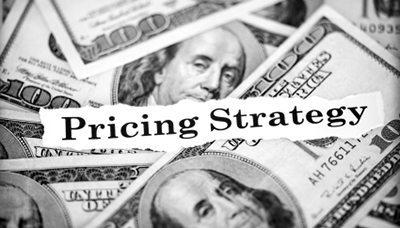
by Fronetics | Jul 1, 2015 | Blog, Leadership, Strategy
 How to increase prices and retain customers
How to increase prices and retain customers
Companies raise prices all the time. There are various reasons, explanations, and results. Sometimes companies disclose the changes, but sometimes customers and clients never even catch wind of a change. Let’s have a look at the causes, the perception, and the actions to take.
Why?
Usually there’s an impetus for a company to raise prices. Perhaps there’s a business model already in place to raise future prices, but often a price increase is tied to another event. Here are some typical reasons:
Spike in raw material prices used in manufacturing products
Is there dearth of raw materials used to make the products your company is producing? Perhaps there’s a lack of access to the materials due to stalled transportation from inclement weather, natural disaster, drought, etc. Perhaps resources are dwindling or other roadblocks in the supply chain are driving up prices.
Services or products have become incredibly popular (value-based pricing)
Perhaps you realize that your services or products weren’t appropriately priced early on, and you’re realizing your product’s value in the market. You may also need to reduce demand for some time by increasing prices.
Unexpected change in business or a new tact
Perhaps you’ve lost business recently or your business strategy has changed and you need to cover costs by increasing prices. These changes can come with the opening of a new branch or factory, or the launch of new services or products.
Inflation and market trends
It would be nice to keep prices where they started 5, 10, or 20 years ago, but most businesses aren’t sustainable that way. As all prices of other goods and services rise, so too must yours.
Perception
As detailed in an article about the power or perception, behavioral economist Richard Thaler ran an experiment in which some study members were asked how much money they would give a friend to go buy beer at a “run-down grocery store”. Some study members were asked to get the alcohol at a “fancy hotel”. According to the article, “the fancy resort’s median price was 71% higher than the run-down store’s price.”
This might suggest that considering the perception of your product or services could be key to your next price adjustment. Considering what your current branding is, who your competitors are, and where you want to see your company could help shift your own perception of your company, and that of others. Aligning the two could be critical to successfully stewarding a price shift.
How?
It’s important thoroughly think through a price adjustment. Considering your own worth is important, but understanding that some clients and customers won’t be convinced can be a hard pill to swallow. To make the change more palatable, or even attractive, you should consider these options:
Consider the tactic (good-value pricing, value-added pricing)
Are you planning on going to offer any promotions or price discounts in the future? Are you going to attach value-added features and services to support the higher prices? Are you considering doing bundles packages? It’s important to answer theses questions so that you can communicate to clients and customers.
Consider timing
Have you recently increased prices? Does it feel too soon to do it again? You could risk loyalty from consumers and clients if price increases come back to back. However some believe that small increases frequently are better than large increases infrequently.
Are you implementing new, improved services or bundling new packages? An announcement tied to value increase or product change can be more comfortable for consumers and clients.
Make a solid announcement
Most people feel it is best to announce an increase, especially to current customers and channel partners, rather than try to hide the increase. People don’t want to feel fooled or ignored. They want transparency.
Understand that wording is critical
Being direct and confident in expressing the increase is the best tact. Remember that if you value your product and services, your customers and clients are more likely to as well.
Although you’re briefly sharing the reason for the increase, don’t feel the need to disclose sensitive financial information.
Lastly, provide clear timing on the changes and be sure that changes don’t violate any pre-existing agreements.
Although some customers and clients may bristle at an increase of prices, if you’ve been playing fairly and providing solid products and services, many loyal customers will come along for the ride. If you value yourself, and others value you, you can survive a price increase. You may even thrive from one.
Fronetics Strategic Advisors is a leading management consulting firm. Our firm works with companies to identify and execute strategies for growth and value creation.
Whether it is a wholesale food distributor seeking guidance on how to define and execute corporate strategy; a telematics firm needing high quality content on a consistent basis; a real estate firm looking for a marketing partner; or a supply chain firm in need of interim management, our clients rely on Fronetics to help them navigate through critical junctures, meet their toughest challenges, and take advantage of opportunities. We deliver high-impact results.
We advise and work with companies on their most critical issues and opportunities: strategy, marketing, organization, talent acquisition, performance management, and M&A support.
We have deep expertise and a proven track record in a broad range of industries including: supply chain, real estate, software, and logistics.


by Elizabeth Hines | Sep 25, 2014 | Blog, Strategy, Supply Chain

Repeat customers contribute to long-term profitability. To keep customers coming back you need to employ the right pricing strategy. What is the right strategy? Here is what to consider when setting prices:
Focus on value pricing
Value pricing is not the same as discount pricing. Rather, value pricing is pricing a product or a service based on what the customer believes it is worth. Price Intelligently puts it this way: “Customers don’t care how much something cost you to make or your competitors, they care how much value they’re receiving at a particular price.”
Figuring what your target customers believe should be the right price takes a lot of time and research. Because of this, many companies steer clear of value pricing. However, by focusing on value pricing you will be able to increase your long-term profitability, gain customers, and develop a following of loyal customers.
Neil Baron wrote a great article for Fast Company on how a dead squirrel taught him about value pricing. The long and short of it, according to Baron: “Many companies worry about the commoditization of their offerings and their inability to justify premium pricing — but if you figure out how to take care of your customers’ ‘dead squirrels,’ you’re golden.”
Make pricing flexible
Once you have determined your value price, don’t be rigid. Rather, set the price with a modicum of flexibility. Even a little flexibility will go a long way in terms of being able to adjust to customer’s needs and the needs of your company.
Eliminate complexity
Complex pricing not only creates a hosts of challenges, it also undermines the credibility of your company and turns off/away customers. Your pricing should be fair, direct, and easy to understand – both internally and externally.
By keeping these things in mind, you should be able to create a pricing strategy that will attract and retain customers – essential components of long-term profitability.

by Elizabeth Hines | Jan 27, 2014 | Blog, Manufacturing & Distribution, Marketing, Supply Chain
This post originally appeared on EBN.

For many customers, both current and prospective, you are your packaging. Take the time to do it right.
I recently read a great piece by Zach Williams, founder and creative director of Venveo, on the role of packaging from a marketing perspective.
Williams puts forth the idea that packaging is a critical element to marketing, and therefore, should become the fifth P in marketing (the other four being Product, Pricing, Placement, and Promotion). He makes the point that “packaging embodies so much more than promotion… [it] can make or break how your company is positioned.”
Williams discusses how packaging can create customer experiences. He offers the example of Apple’s packaging and how getting a box with the Apple logo on it creates an emotional response for customers. So emotional is the response that Williams pointed out that there are videos on YouTube of people “unboxing” their new products. When Williams wrote the article in October 2012, there were “thousands” of videos; when I looked today there were close to 3.5 million. That growth alone says a lot. And, the joy and excitement displayed in the videos speaks volumes to Apple, the product, and to the packaging itself.
Another company whose packaging has become iconic in the realm of creating customer experience is Tiffany & Co… New York Times writer Alice Rawsthorn wrote an articleabout the role Tiffany’s packaging played in her decision to purchase a pendant for her goddaughter: “Would I have bought that pendant without the packaging? I’m not sure, but the thought of Delilah opening that duck egg blue box tied with white satin ribbon certainly clinched my choice.”
Williams also notes that packaging can also serve to justify the price of the product and that “packaging should always aim to increase the perceived value of the product.” To Williams’s point, look at both Apple and Tiffany — their prices are higher than their competitors.
The final point in Williams’s article is that the packaging of a company needs to go beyond the physical and extend to the company’s website — that the website “can be considered packaging as well.” The point is a good one, but I think it should go further. I believe packaging should not only include the company’s website, but should also extend to the company’s Facebook and LinkedIn pages, Twitter account, blog, and any outward-facing materials. If your company does not take the time to create an exceptional package for customers, you will be passed over.
Your company’s physical packaging and online packaging speaks volumes about your company. For many customers, current and prospective, you are your packaging. Take the time to do it right.

by Elizabeth Hines | Jan 27, 2014 | Blog, Manufacturing & Distribution, Marketing, Supply Chain
This post originally appeared on EBN.

For many customers, both current and prospective, you are your packaging. Take the time to do it right.
I recently read a great piece by Zach Williams, founder and creative director of Venveo, on the role of packaging from a marketing perspective.
Williams puts forth the idea that packaging is a critical element to marketing, and therefore, should become the fifth P in marketing (the other four being Product, Pricing, Placement, and Promotion). He makes the point that “packaging embodies so much more than promotion… [it] can make or break how your company is positioned.”
Williams discusses how packaging can create customer experiences. He offers the example of Apple’s packaging and how getting a box with the Apple logo on it creates an emotional response for customers. So emotional is the response that Williams pointed out that there are videos on YouTube of people “unboxing” their new products. When Williams wrote the article in October 2012, there were “thousands” of videos; when I looked today there were close to 3.5 million. That growth alone says a lot. And, the joy and excitement displayed in the videos speaks volumes to Apple, the product, and to the packaging itself.
Another company whose packaging has become iconic in the realm of creating customer experience is Tiffany & Co… New York Times writer Alice Rawsthorn wrote an articleabout the role Tiffany’s packaging played in her decision to purchase a pendant for her goddaughter: “Would I have bought that pendant without the packaging? I’m not sure, but the thought of Delilah opening that duck egg blue box tied with white satin ribbon certainly clinched my choice.”
Williams also notes that packaging can also serve to justify the price of the product and that “packaging should always aim to increase the perceived value of the product.” To Williams’s point, look at both Apple and Tiffany — their prices are higher than their competitors.
The final point in Williams’s article is that the packaging of a company needs to go beyond the physical and extend to the company’s website — that the website “can be considered packaging as well.” The point is a good one, but I think it should go further. I believe packaging should not only include the company’s website, but should also extend to the company’s Facebook and LinkedIn pages, Twitter account, blog, and any outward-facing materials. If your company does not take the time to create an exceptional package for customers, you will be passed over.
Your company’s physical packaging and online packaging speaks volumes about your company. For many customers, current and prospective, you are your packaging. Take the time to do it right.

 How to increase prices and retain customers
How to increase prices and retain customers


